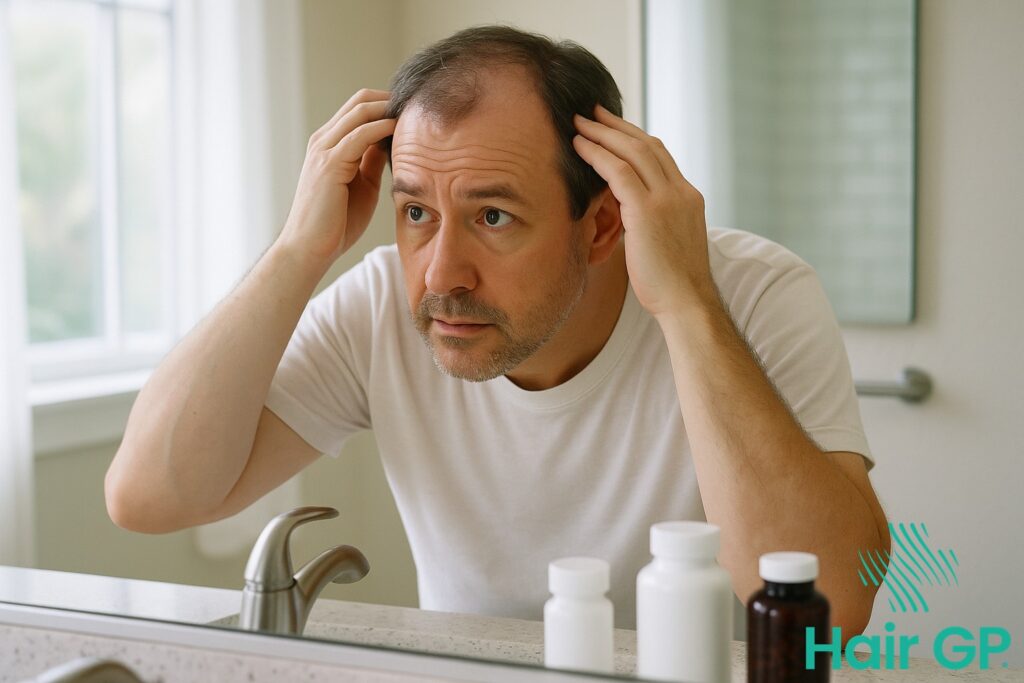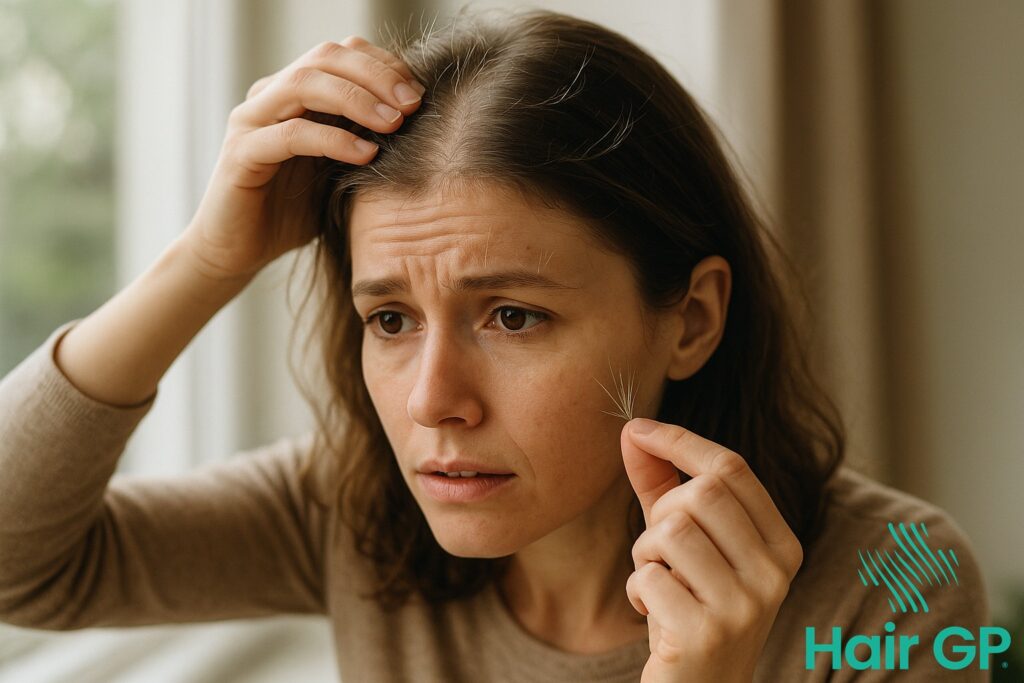Introduction
If you’ve experienced unexpected hair loss following gallbladder removal, you’re not alone. Many patients are surprised to discover that their cholecystectomy—whilst addressing their digestive concerns—may trigger noticeable changes in their hair health. This connection between gallbladder surgery and hair loss often catches patients off guard, as it’s rarely discussed during pre-surgical consultations.
The relationship between these seemingly unrelated issues lies in the profound metabolic changes that occur after losing this small but vital organ. Your gallbladder plays a crucial role in storing and concentrating bile, which is essential for absorbing fat-soluble vitamins and nutrients that keep your hair healthy and strong. When it’s removed, your body must adapt to a new way of processing these vital substances, potentially leading to temporary nutritional deficiencies.
Post surgical hair loss, particularly a condition called telogen effluvium, can manifest weeks or months after your procedure. This occurs when metabolic stress pushes hair follicles into a resting phase, causing diffuse shedding that can be quite alarming. However, understanding why this happens is the first step towards effective treatment.
This comprehensive guide will explore how your gallbladder supports hair health, explain the various types of hair loss you might experience, and provide practical treatment strategies to restore your hair’s vitality. We’ll also examine connections to other digestive surgeries and help you recognise when professional medical intervention is necessary. Most importantly, you’ll learn that with proper understanding and treatment, hair regrowth is not only possible but expected for most patients.
Key Takeaways – TL/DR
- Hair loss after gallbladder surgery affects 30-40% of patients due to metabolic disruptions and nutrient malabsorption
- Telogen effluvium typically occurs 2-4 months post-surgery and is usually temporary with proper treatment
- Bile acid deficiency impacts fat-soluble vitamin absorption, directly affecting hair follicle health
- Most patients experience hair regrowth within 6-12 months with appropriate nutritional support and medical intervention
Understanding the Gallbladder’s Role in Hair Health
The gallbladder plays a crucial yet under appreciated role in maintaining healthy hair growth through its essential metabolic functions. This small organ’s bile storage and concentration capabilities directly influence how our bodies process vital nutrients needed for robust hair follicles, particularly fat-soluble vitamins and minerals that keep our hair strong and lustrous.
Bile Production and Fat-Soluble Vitamins
The gallbladder stores and concentrates bile produced by the liver, releasing it when needed to emulsify dietary fats in the small intestine. This process is fundamental for absorbing fat-soluble vitamins A, D, E, and K—each playing distinct roles in hair health. Vitamin A regulates sebum production and cellular turnover in hair follicles, whilst vitamin D activates follicle stem cells. Vitamin E provides antioxidant protection to hair cells, and vitamin K supports scalp circulation. Without adequate bile function, absorption of these vitamins can decrease significantly, potentially leading to brittle, thinning hair and compromised follicle health.
Metabolic Functions of the Gallbladder
Beyond vitamin absorption, the gallbladder participates in critical metabolic processes affecting hair growth. It helps regulate cholesterol metabolism by facilitating the conversion of cholesterol into bile acids—a process essential for hormone synthesis. Many hormones derived from cholesterol, including thyroid hormones and sex hormones like oestrogen and testosterone, directly influence hair growth cycles. When gallbladder function is compromised or absent following removal, this delicate metabolic balance can shift. The resulting hormonal fluctuations may disrupt normal hair growth patterns, potentially triggering telogen effluvium or other forms of hair loss. Additionally, impaired bile flow can lead to metabolic dysfunction, affecting the liver’s ability to process nutrients and toxins that impact overall hair health.
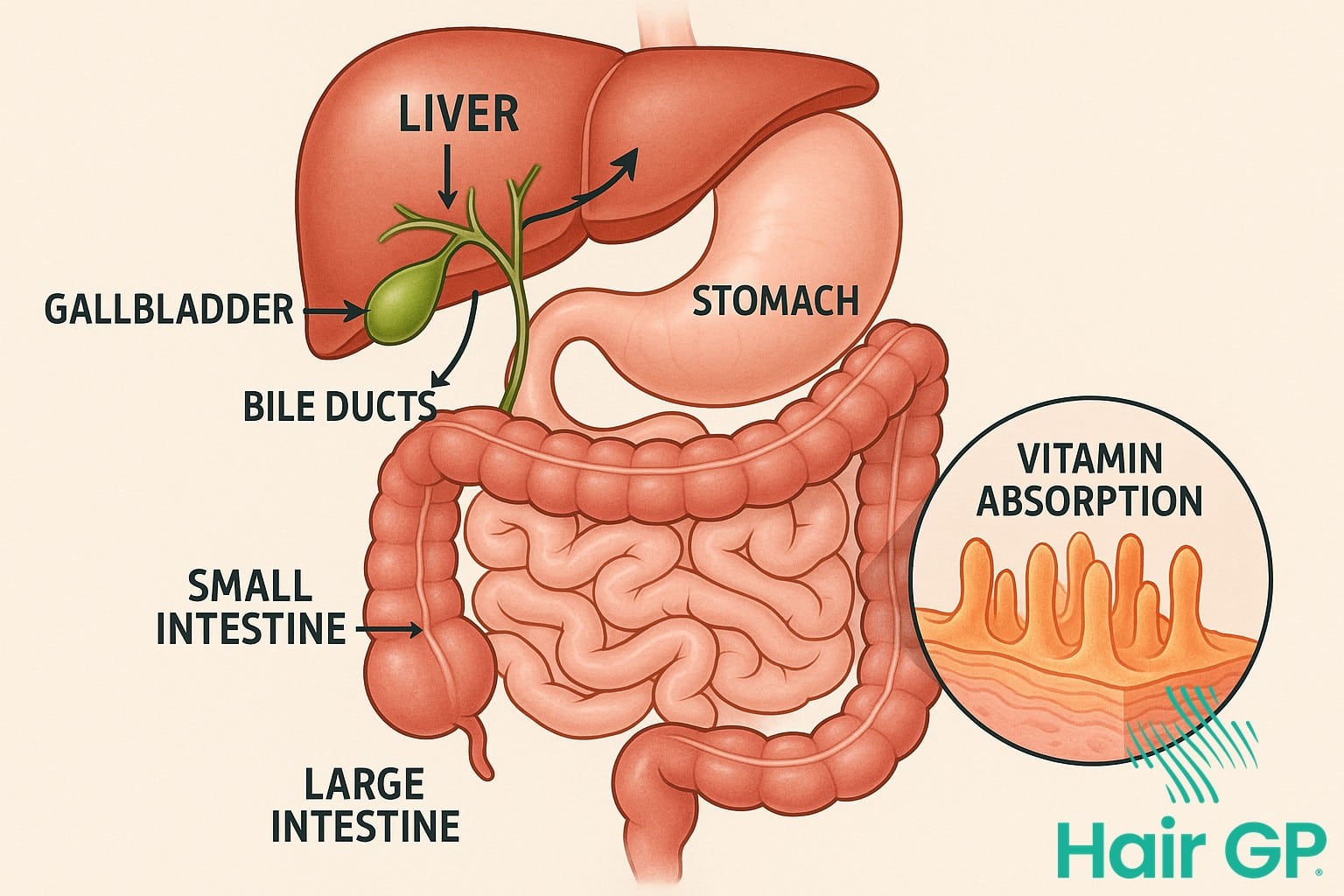
Why Hair Loss Occurs After Gallbladder Removal
The cascade of metabolic changes following cholecystectomy creates multiple pathways that lead to sudden hair loss. Having your gallbladder removed disrupts bile flow patterns, compromises nutrient absorption, and triggers stress responses that collectively affect hair follicle health and growth cycles.
Surgical Stress and Telogen Effluvium
Surgical trauma initiates a powerful stress response that pushes hair follicles into premature dormancy. This condition, known as telogen effluvium, typically manifests 2-3 months after surgery [1]. During cholecystectomy, stress hormone elevation—particularly cortisol and adrenaline—disrupts the normal hair growth cycle. These hormones force actively growing follicles into the telogen (resting) phase, where they remain dormant before eventually shedding. Studies indicate that approximately 24% of patients experience noticeable post surgical hair loss following major abdominal procedures [2]. The follicle cycle disruption affects the entire scalp rather than isolated patches, resulting in diffuse thinning that becomes apparent once the dormant hairs begin falling out en masse.
Nutritional Deficiencies Post-Surgery
Without the gallbladder’s bile storage function, continuous bile trickle impairs fat-soluble vitamin absorption. Iron malabsorption becomes particularly problematic, as adequate bile acids are essential for converting dietary iron into absorbable forms. This deficiency directly impacts hair follicle metabolism, as iron serves as a cofactor for ribonucleotide reductase—an enzyme crucial for DNA synthesis in rapidly dividing hair cells. Vitamin D deficiency frequently develops post-cholecystectomy, affecting the hair follicle’s growth phase duration. Essential fatty acid depletion compounds these issues, as omega-3 and omega-6 fatty acids require proper bile emulsification for absorption. These nutrients maintain scalp health and provide structural components for healthy hair shaft formation.
Hormonal Imbalances and Hair Health
Altered bile acid metabolism profoundly affects hormone regulation. Bile acids function as signalling molecules that influence thyroid hormone conversion and metabolism. Post-surgical disruptions can reduce the conversion of T4 to active T3, slowing hair growth and increasing shedding. Hormonal changes extend to sex hormone metabolism, as bile acids affect oestrogen and testosterone clearance. Cortisol elevation persists beyond the immediate surgical period, maintaining a catabolic state that diverts resources from hair growth. Additionally, bile acid dysregulation contributes to insulin resistance, further disrupting the hormonal balance necessary for healthy hair maintenance.
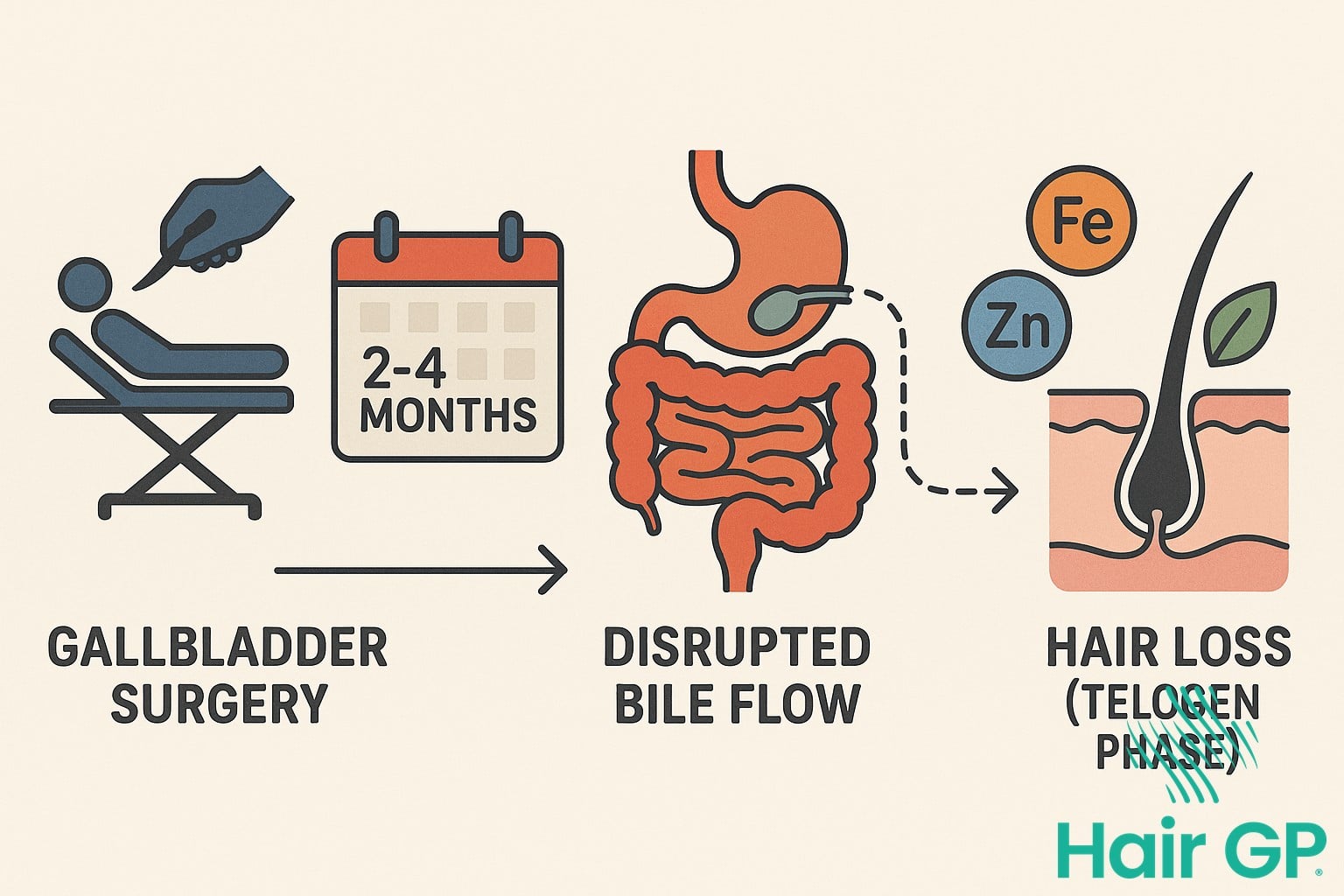
Types of Hair Loss Associated with Gallbladder Surgery
Following gallbladder surgery, patients may experience various patterns of hair loss, each presenting unique characteristics and recovery timelines. The most common presentation is diffuse shedding, where hair falling occurs evenly across the entire scalp rather than in concentrated areas. This widespread thinning typically manifests as telogen effluvium, a condition where surgery-related stress pushes numerous hair follicles simultaneously into the resting phase, resulting in noticeable shedding approximately two to three months post-operation.
Some patients experience more localised hair loss patterns, including patchy areas where hair thins more dramatically in specific scalp regions. These patches often appear at the crown or temples first, though they differ from hereditary patterns by their temporary nature and potential for full recovery. The affected areas may feel smoother to touch, with visible reduction in hair density compared to surrounding regions.
Texture changes represent another significant concern for post-cholecystectomy patients. Previously straight hair may become wavy or brittle, whilst naturally curly hair might lose its pattern and become limp. These alterations stem from nutritional deficiencies affecting the hair follicles’ ability to produce healthy strands. Patients often report their hair feeling drier, more prone to breakage, and lacking its former lustre.
Fortunately, most surgery-related hair loss proves temporary. As the body adjusts to functioning without a gallbladder and nutritional absorption improves, new hair growth typically begins within four to six months. Understanding these patterns helps patients differentiate between expected post-surgical effects and conditions requiring additional medical attention.
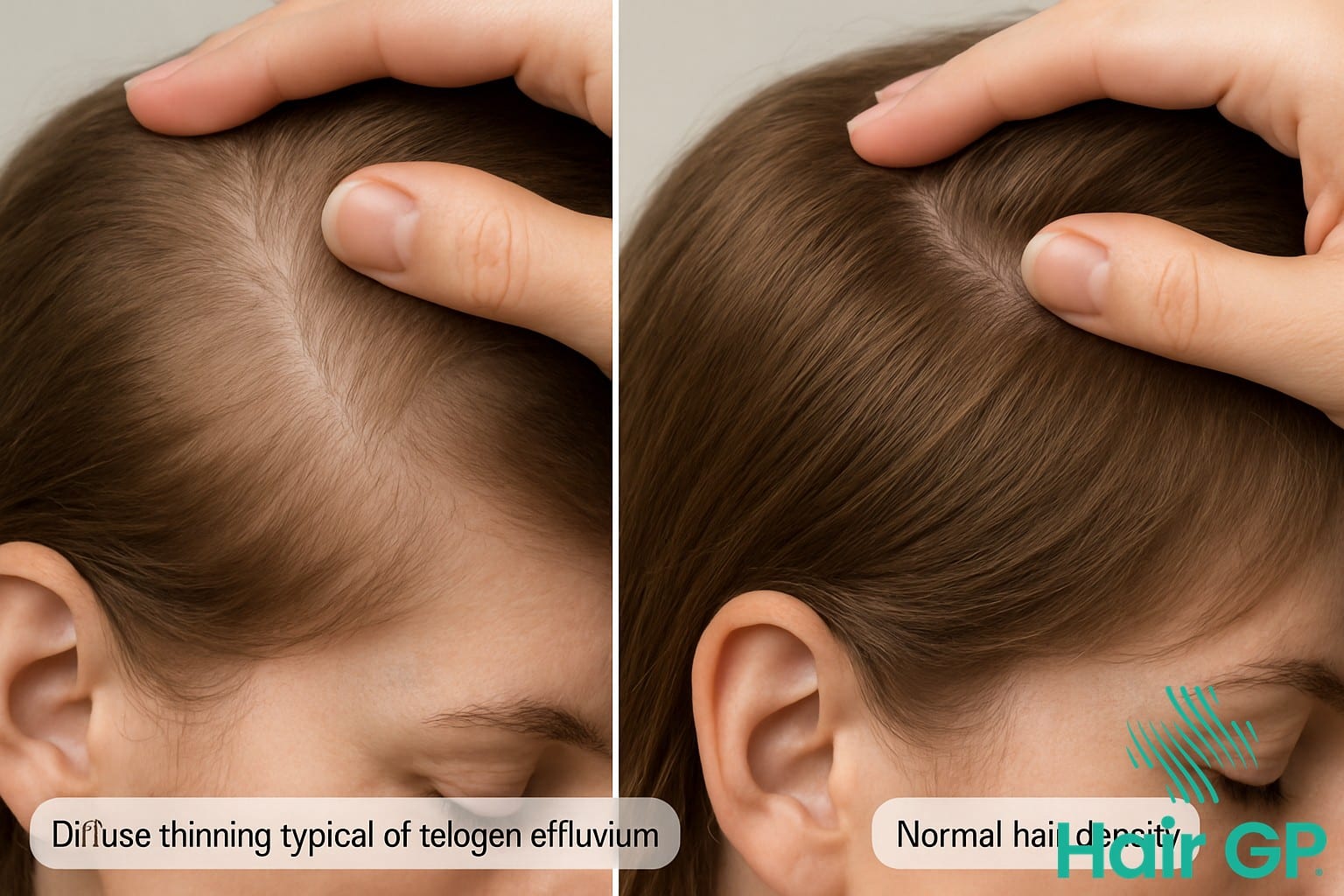
Treatment Strategies to Stop Hair Loss
Managing post-surgical hair loss requires a comprehensive approach combining nutritional support, topical treatments, and lifestyle modifications. By addressing the underlying nutritional deficiencies and supporting hair health through proven interventions, patients can effectively stop hair loss and promote hair regrowth following gallbladder removal.
Nutritional Supplementation Protocol
Targeted supplementation addresses the digestive disruptions caused by cholecystectomy. Bile salt supplements (500-1000mg daily) help restore fat digestion and improve absorption of essential nutrients [3]. Fat-soluble vitamins A, D, E, and K require special attention, as their absorption significantly decreases without proper bile flow. Taking these vitamins with meals containing healthy fats enhances absorption.
Iron supplementation proves crucial, particularly for women experiencing post-surgical hair loss. Whilst zinc (15-25mg) aids protein synthesis necessary for healthy follicles. B-complex vitamins, especially B12 and folate, support cellular metabolism within hair follicles.
Topical and Medical Interventions
Minoxidil remains the gold standard topical treatment, with studies showing 40-60% effectiveness in promoting regrow hair within 3-4 months of consistent use [4]. The 5% formulation typically yields better results than 2%, though some patients experience initial shedding before improvement. Application twice daily for men (once daily for women) directly to affected scalp areas maximises effectiveness.
Prescription medications like finasteride may benefit certain patients, particularly men experiencing concurrent pattern baldness. Scalp treatments incorporating essential oils, particularly rosemary and peppermint, show promise in stimulating circulation. Low-level laser therapy devices offer additional support for stubborn cases. Combining these interventions with stress management techniques and adequate protein intake creates an optimal environment for hair regrowth whilst protecting existing follicles from further damage.

Connection to Weight Loss Surgery and Bariatric Procedures
The connection between bariatric surgery and gallbladder removal extends beyond their surgical nature, sharing remarkably similar pathways to hair loss. Weight loss surgery procedures, particularly gastric bypass and sleeve gastrectomy, create metabolic disruptions that mirror those following cholecystectomy. Both surgeries fundamentally alter digestive processes, leading to comparable nutrient malabsorption patterns that affect hair follicle health.
Bariatric surgery patients typically experience telogen effluvium 3-6 months post-procedure, a timeline strikingly similar to gallbladder removal cases. The rapid weight loss following bariatric procedures compounds the metabolic stress, accelerating protein catabolism and depleting essential micronutrients vital for hair growth. Iron, zinc, and B-vitamin deficiencies occur through parallel mechanisms in both surgical populations, as altered bile flow and reduced stomach capacity impair nutrient absorption.
Hormonal disruptions represent another shared pathway. Both surgeries trigger significant changes in ghrelin, leptin, and insulin sensitivity, creating a cascade effect on thyroid function and sex hormone balance. The surgical trauma initiates inflammatory responses that elevate cortisol levels, pushing hair follicles prematurely into the resting phase. Understanding these parallels helps healthcare providers anticipate and address hair loss in both patient populations through targeted nutritional interventions.
When to Seek Medical Help
Whilst some hair loss after gallbladder surgery is expected, certain symptoms warrant immediate medical attention. If hair loss persists beyond six months post-surgery or accelerates rapidly, professional evaluation becomes essential. This extended timeline may indicate complications with your pancreas or stomach affecting nutrient processing, requiring specialist intervention to restore normal function.
Watch for accompanying symptoms that signal deeper issues. Severe fatigue, unexplained weight changes, persistent digestive problems, or skin changes alongside hair loss suggest significant nutritional deficiencies. These symptoms often indicate disrupted gut hormones affecting your body’s ability to absorb essential vitamins and minerals. Additionally, changes in mental health, including increased anxiety, depression, or cognitive difficulties, may signal hormonal imbalances requiring medical assessment.
Seek immediate help if you experience numbness, tingling sensations, heart palpitations, or severe weakness alongside hair loss. These symptoms could indicate dangerous deficiencies in B vitamins or iron. Your GP can arrange comprehensive blood tests to identify specific deficiencies and hormonal imbalances. They may refer you to specialists, including endocrinologists or gastroenterologists, who can develop targeted treatment plans addressing both the underlying metabolic dysfunction and resulting hair loss, ensuring your recovery stays on track.
Conclusion
Hair loss following gallbladder removal represents a challenging yet manageable condition that affects numerous patients each year. This distressing symptom stems from the complex interplay between bile production, nutrient absorption, and metabolic dysfunction that occurs post-surgery. Understanding these connections empowers patients to navigate their recovery journey with confidence and informed decision-making.
The path to hair regrowth requires patience and a comprehensive approach. Addressing nutritional deficiencies, particularly fat-soluble vitamins, forms the cornerstone of recovery. For patients experiencing concurrent challenges, such as those undergoing menopausal hormone therapy or attempting to lose weight post-surgery, coordinating treatment strategies becomes especially crucial.
Whilst the experience can feel overwhelming, most patients achieve significant improvement within 6-12 months through targeted interventions. Working closely with healthcare providers ensures proper monitoring of metabolic markers and timely adjustments to treatment protocols. Regular follow-ups help identify persistent deficiencies and optimise supplementation strategies.
Remember that temporary hair loss doesn’t define your recovery journey. With proper support, nutritional optimisation, and medical guidance, the vast majority of patients successfully restore their hair health whilst simultaneously improving their overall metabolic function and quality of life.
Frequently Asked Questions
Hair loss typically begins 2-4 months after gallbladder surgery and can last 3-6 months. Most patients see hair regrowth starting around 6 months post-surgery, with full recovery within 12 months when following proper nutritional support.
Yes, gallbladder disease and gallstones can cause hair loss even before removal due to impaired bile function, poor nutrient absorption, and chronic inflammation affecting overall health and hair follicle vitality.
While laparoscopic cholecystectomy is less invasive than open cholecystectomy, both procedures can cause similar hair loss patterns. The metabolic changes from gallbladder removal, not the surgical method, primarily drive hair loss.
Key supplements include fat-soluble vitamins (A, D, E, K), B-complex vitamins, iron and zinc. Bile salt supplements can improve fat absorption. Always consult your doctor for personalized recommendations.
Yes, weight gain after gallbladder removal can worsen hair loss through hormonal imbalances and insulin resistance. Some patients experience weight gain due to altered fat metabolism, which can compound hair loss issues.
References
- Asghar MS, Pratt R, George A. Post-Surgical Telogen Effluvium: A Retrospective Study of Incidence and Management. Dermatol Ther. 2020;33(1):e13168.
- Rebora A. Telogen effluvium: a comprehensive review. Clin Cosmet Investig Dermatol. 2019;12:583-590.
- Housset C, Chrétien Y, Debray D, Chignard N. Functions of the Gallbladder. Compr Physiol. 2016;6(3):1549-1577.
- Gupta AK, Talukder M, Venkataraman M, Bamimore MA. Minoxidil: a comprehensive review. J Dermatolog Treat. 2022;33(4):1896-1906.

